This article was medically reviewed by Joshua Grahlman, PT, DPT, FAFS. Dr. Joshua Grahlman, PT, DPT, FAFS, is the Founder and Chief Athlete Mechanic of Clutch PT + Performance, a private physical therapy clinic specializing in sports and orthopedics in New York City. With more than a decade of experience, Dr. Grahlman specializes in treating acute and chronic pain and injuries, sports performance optimization and post-operative rehabilitation. Dr. Grahlman earned his Doctorate of Physical Therapy (DPT) from Columbia University College of Physicians and Surgeons. He is one of just a few DPTs in New York City recognized as a Fellow in Applied Functional Science through the Gray Institute for Functional Transformation (GIFT). He is certified in Active Release Technique and Spinal Manipulation and is a TRX Suspension Training Specialist. Dr. Grahlman has spent his career treating athletes of all levels, from Ironman Champions and Olympians to marathoner moms. He consults for Triathlete, Men’s Health, My Fitness Pal and CBS News.
There are 8 references cited in this article, which can be found at the bottom of the page.
wikiHow marks an article as reader-approved once it receives enough positive feedback. In this case, 80% of readers who voted found the article helpful, earning it our reader-approved status.
This article has been viewed 94,353 times.
Experts agree that carpal tunnel syndrome typically causes numbness, tingling, and weakness in your wrist and hand. Your symptoms are caused by a compression of your median nerve, which passes through a narrow passageway in your hand that's called the carpal tunnel.[1] Research suggests that carpal tunnel syndrome is typically caused by factors like injury, repetitive movement, conditions that cause inflammation, or a smaller than average carpal tunnel.[2] Although you may be able to relieve your symptoms at home, it's best to visit your doctor to get treatment for carpal tunnel syndrome, as it can worsen over time.
Steps
Dealing with Carpal Tunnel Syndrome at Home
-
1Avoid irritating your median nerves. The carpal tunnel within your wrist is a narrow passageway made up of small carpal bones and ligaments.[3] The tunnel protects nerves, blood vessels and tendons that go into your hand. The main nerve that innervates your hand is called the median nerve.[4] Avoid activities that compress and irritate the median nerve such as repetitively flexing your wrist, lifting heavy weights with your hands, sleeping with bent wrists and punching solid objects.
- Wearing tight bracelets and watches may be a risk factor also, so make sure to leave ample space.
- In many cases of carpal tunnel syndrome, a single cause is difficult to identify. Often it involves a combination of factors, such as arthritis or diabetes combined with repetitive strain in the wrist.
- The wrist anatomy of people can make a difference — some have naturally smaller passageways in their wrists or have carpal bones that are positioned oddly.
-
2Stretch your wrists.[5] Stretching your wrists on a regular basis can be effective at reducing or minimizing carpal tunnel symptoms.[6] In particular, wrist extensions can help make more room for the median nerve in the carpal tunnel by stretching the ligaments that attach to the carpal bones. The easiest way to extend and stretch both wrists at the same time is the "prayer pose" with your palms together. Put your palms together in front of your chest and raise your elbows until you feel a nice stretch in your wrists. Hold for 30 seconds and repeat 3-5x daily.
- You can also grab the fingers of the affected hand and pull backwards until you feel a stretch at the front of your wrist. You may feel more temporary tingling in your hand with this stretch, but don't stop unless you feel pain.
- In addition to hand tingling, other symptoms commonly associated with carpal tunnel syndrome are: numbness, throbbing pain, muscle weakness and color changes (too pale or too red).
- The only part of the wrist/hand typically spared symptoms is the little finger — it's not innervated by the median nerve.
Advertisement -
3Take over-the-counter (OTC) anti-inflammatories. The symptoms of carpal tunnel are often related to having inflammation/swelling in the wrist, which either directly irritates the median nerve or crowds (pinches) it. As such, taking OTC non-steroidal anti-inflammatories (NSAIDs), such as ibuprofen (Motrin, Advil) or naproxen (Aleve), can be very helpful to reduce symptoms short term.[7] Painkillers such as acetaminophen (Tylenol, Paracetamol) can be used for carpal tunnel also, but they don't impact swelling, only the pain.
- Anti-inflammatories and analgesics should be considered short-term strategies for pain control. There isn't any evidence that these drugs improve carpal tunnel syndrome in the long term.[8]
- Taking too many NSAIDs or taking them for too long significantly increases your risk of stomach irritation, ulcers and kidney failure.
- Taking too much acetaminophen or taking it for too can cause liver damage.
- As an alternative, rub an ointment that contains a natural pain reliever into your sore wrist/hand. Menthol, camphor, arnica and capsaicin are all helpful for relieving mild-to-moderate pain.
-
4Use cold therapy. If your wrist is sore and looks or feels swollen, then apply a small bag of crushed ice (or something cold) to it in order to reduce inflammation and numb the pain. Doing so may also reduce hand symptoms. Cold therapy is most effective for soft-tissue injuries that involve some sort of swelling because it reduces blood flow.[9] Apply the crushed ice to your wrist for about 5-10 minutes 3-5x daily until the symptoms subside.
- Compressing the ice against your wrist with a stretchy Tensor or Ace bandage is even more effective for fighting inflammation.
- Always wrap ice in a thin cloth before applying it skin — it prevents skin irritation or frostbite.
- If crushed ice isn't available, use a large ice cube, frozen gel pack or small bag of frozen veggies instead.
- In some cases, cold therapy may aggravate the symptoms of carpal tunnel syndrome. Avoid ice if that's the case with you.
Changing Your Habits
-
1Wear a wrist splint. Wearing a rigid brace or splint that holds your wrist in a neutral position during the day may reduce the compression or irritation of the median nerve and help with carpal tunnel symptoms.[10] Splints or wrist braces can also be worn during activities that aggravate symptoms, such as working at the computer, bowling or carrying groceries. Wearing splints while you sleep can help relieve nighttime symptoms of tingling and numbness in your hands, especially if you have a habit of curling your wrists.[11]
- You may need to wear a splint for several weeks (day and night) to get significant relief from carpal tunnel symptoms. For some sufferers, splints and braces provide negligible benefit.
- Splinting at night can be a good idea if you're pregnant and have carpal tunnel syndrome because pregnancy tends to increase swelling (edema) in the hands and feet.
- Wrist splints and braces can be purchased at most pharmacies and medical supply stores.
-
2Change your sleeping position.[12] Some sleeping postures can aggravate the symptoms of carpal tunnel syndrome. Sleeping with your fists clenched and wrists tucked in (flexed) is the worst position, but having your arms extended above your head is not great either. Instead, sleep on your back or side with your arms at your sides, and try to keep your hands open and your wrists in a neutral position. Wearing a wrist splint or brace is very helpful in this regard, although it takes a little getting used to.
- Don't sleep on your stomach with your hands/wrists compressed under your pillow. People who do this frequently wake up with numb and tingly hands.
- Most wrist splints and braces are made of nylon and fasten with velcro, which can irritate other parts of your body. Consider covering your splint with a sock or thin cloth to reduce irritating other body parts.
-
3Alter your work station. Your carpal tunnel problem may be caused or aggravated by a poorly designed work station. If your computer keyboard, mouse, desk and/or chair isn't positioned properly for your height and body proportions, it can put strain on your wrists, shoulders, neck and mid-back. Make sure your keyboard is low enough so that your wrists are not constantly bent upwards while typing. Consider getting an ergonomic keyboard and mouse, designed to take the stress off your wrists and hands.
- Putting cushioned pads underneath your keyboard and mouse can lessen the impact on your hands and wrists.
- Have an occupational therapist review your body positions while performing your job.
- People who work on computers for many hours each day are at higher risk of carpal tunnel syndrome.[13]
Getting Treatment for Carpal Tunnel Syndrome
-
1Make an appointment with your doctor. If you are feeling any carpal tunnel symptoms in your wrist and hand that persist for more than a few weeks, then see your doctor for an examination. Your doctor may take x-rays and blood tests to rule out other causes of wrist/hand pain, such as rheumatoid arthritis, osteoarthritis, advanced diabetes, hairline fractures or vascular problems.
- Electrodiagnostic studies (EMG and nerve conduction) are usually done to confirm the diagnosis of carpal tunnel syndrome.[14]
- Your doctor will see if you can perform certain tasks that are difficult with carpal tunnel syndrome, such as: making a tight fist, pinching your thumb and forefinger together and manipulating small objects with precision.[15]
- Your doctor may ask about your profession, as certain jobs are at high risk: carpenters, cashiers, assembly-line workers, musicians, auto mechanics and people who work on computers for long hours.
-
2Ask about corticosteroid injections. Your doctor may recommend injecting the carpal tunnel area of your wrist with corticosteroid medication, such as cortisone, to relieve the pain, inflammation and other symptoms.[16] Corticosteroids are strong and fast-acting anti-inflammatories that can quickly decrease swelling in your wrist, which relieves pressure on the median nerve. Taking oral corticosteroids (by mouth) is another option, but these drugs are not considered as effective as injections and they come with significant side effects.
- Other common corticosteroid medications used for carpal tunnel syndrome are prednisolone, dexamethasone and triamcinolone.
- Potential complications of corticosteroid injections include local infection, bleeding, tendon weakening, local muscle atrophy and nerve irritation/damage. As such, injections are limited to 2 per year.
- If corticosteroid injections fail to significantly reduce the symptoms of carpal tunnel syndrome, then surgery should be considered.
-
3Consider surgery as a last resort. If all other remedies and treatments fail to give you relief, then your doctor will likely recommend carpal tunnel surgery. Surgery should be considered as a last resort, although it can completely relieve your symptoms for good with minimal risk, so it should not be considered as a long shot. The goal of surgery is to relieve pressure on the median nerve by cutting the ligament pressing on it.[17] However, carpal tunnel surgery can be performed in two different ways: endoscopic or open surgery.
- Endoscopic surgery involves uses a telescope-like device with a tiny camera on the end (endoscope), which is inserted through a small incision in your wrist or hand. The endoscope can see inside the carpal tunnel and cut the problematic ligament.
- Endoscopic surgery typically results in the least amount of pain and the quickest recovery.
- Open surgery involves making a larger incision in the palm of your hand and over your wrist in order to cut through the problematic ligament, which frees the nerve.
- Surgery risks include: nerve damage, infection and scar tissue formation.
-
4Be patient with recovery. Following the surgery (it's done on an outpatient basis), you'll be asked to often elevate your hand above your heart and move your fingers, which reduces swelling and prevents stiffness.[18] Mild pain, swelling and stiffness in the palm and wrist can be expected post surgery for up to 6 months, and complete recovery may take a year. For the first 2-4 weeks, you may be required to wear a splint or brace, although using your hand is encouraged.
- Most people's symptoms get much better after surgery, but recovery is often slow and gradual. On average, hand strength returns to normal 2 months after surgery.[19]
- Carpal tunnel syndrome can occasionally recur (about 10% of the time) and may require additional surgery.
Expert Q&A
Did you know you can get expert answers for this article?
Unlock expert answers by supporting wikiHow
-
QuestionWhat can you do to relieve carpal tunnel pain?
 Joshua Grahlman, PT, DPT, FAFSDr. Joshua Grahlman, PT, DPT, FAFS, is the Founder and Chief Athlete Mechanic of Clutch PT + Performance, a private physical therapy clinic specializing in sports and orthopedics in New York City. With more than a decade of experience, Dr. Grahlman specializes in treating acute and chronic pain and injuries, sports performance optimization and post-operative rehabilitation. Dr. Grahlman earned his Doctorate of Physical Therapy (DPT) from Columbia University College of Physicians and Surgeons. He is one of just a few DPTs in New York City recognized as a Fellow in Applied Functional Science through the Gray Institute for Functional Transformation (GIFT). He is certified in Active Release Technique and Spinal Manipulation and is a TRX Suspension Training Specialist. Dr. Grahlman has spent his career treating athletes of all levels, from Ironman Champions and Olympians to marathoner moms. He consults for Triathlete, Men’s Health, My Fitness Pal and CBS News.
Joshua Grahlman, PT, DPT, FAFSDr. Joshua Grahlman, PT, DPT, FAFS, is the Founder and Chief Athlete Mechanic of Clutch PT + Performance, a private physical therapy clinic specializing in sports and orthopedics in New York City. With more than a decade of experience, Dr. Grahlman specializes in treating acute and chronic pain and injuries, sports performance optimization and post-operative rehabilitation. Dr. Grahlman earned his Doctorate of Physical Therapy (DPT) from Columbia University College of Physicians and Surgeons. He is one of just a few DPTs in New York City recognized as a Fellow in Applied Functional Science through the Gray Institute for Functional Transformation (GIFT). He is certified in Active Release Technique and Spinal Manipulation and is a TRX Suspension Training Specialist. Dr. Grahlman has spent his career treating athletes of all levels, from Ironman Champions and Olympians to marathoner moms. He consults for Triathlete, Men’s Health, My Fitness Pal and CBS News.
Physical Therapist & Entrepreneur Carpal tunnel basically describes when the tendons in your wrist get stuck and don't glide so well through what's called your retinaculum at your wrist underneath your skin. That inflammation and pain you experience in your wrist is really caused by a lack of mobility there. The best thing that you can do are what's called tendon-gliding exercises. Try putting your hand up in front of your face with your fingers completely extended up, then bend the knuckles closest to your wrist.
Carpal tunnel basically describes when the tendons in your wrist get stuck and don't glide so well through what's called your retinaculum at your wrist underneath your skin. That inflammation and pain you experience in your wrist is really caused by a lack of mobility there. The best thing that you can do are what's called tendon-gliding exercises. Try putting your hand up in front of your face with your fingers completely extended up, then bend the knuckles closest to your wrist. -
QuestionHow can I relieve carpal tunnel pain?
 David Schechter, MDDr. David Schechter is a physician in Culver City, California. With over 25 years of experience as a family and sports medicine physician, Dr. Schechter specializes in mind-body medicine, preventive medicine, and chronic pain. Dr. Schechter received his MD from New York University and is an attending physician at Cedars-Sinai Medical Center. He was named a Top Doctor by Los Angeles Magazine and Men's Health Magazine. He has also written several books, including The MindBody Workbook.
David Schechter, MDDr. David Schechter is a physician in Culver City, California. With over 25 years of experience as a family and sports medicine physician, Dr. Schechter specializes in mind-body medicine, preventive medicine, and chronic pain. Dr. Schechter received his MD from New York University and is an attending physician at Cedars-Sinai Medical Center. He was named a Top Doctor by Los Angeles Magazine and Men's Health Magazine. He has also written several books, including The MindBody Workbook.
Family Medicine Practitioner Stretch your wrist up and down, and use the other hand to provide some resistance or some extra aid in the stretching. There's also a wrist massage you can do where you massage in the space between the bones to relieve some of the pressure on the carpal tunnel. Also, look at what might be causing the carpal tunnel—ask yourself whether there are any ergonomic changes you can make to put less stress on your wrist and hand.
Stretch your wrist up and down, and use the other hand to provide some resistance or some extra aid in the stretching. There's also a wrist massage you can do where you massage in the space between the bones to relieve some of the pressure on the carpal tunnel. Also, look at what might be causing the carpal tunnel—ask yourself whether there are any ergonomic changes you can make to put less stress on your wrist and hand.
References
- ↑ https://orthoinfo.aaos.org/en/diseases--conditions/carpal-tunnel-syndrome/
- ↑ https://www.mayoclinic.org/diseases-conditions/carpal-tunnel-syndrome/symptoms-causes/syc-20355603
- ↑ Joshua Grahlman, PT, DPT, FAFS. Physical Therapist & Entrepreneur. Expert Interview. 8 September 2020.
- ↑ http://www.hopkinsmedicine.org/neurology_neurosurgery/centers_clinics/peripheral_nerve_surgery/conditions/carpal_tunnel_syndrome.html
- ↑ Joshua Grahlman, PT, DPT, FAFS. Physical Therapist & Entrepreneur. Expert Interview. 8 September 2020.
- ↑ http://www.medicinenet.com/carpal_tunnel_syndrome/page3.htm#what_is_the_treatment_for_carpal_tunnel_syndrome_is_it_possible_to_prevent_carpal_tunnel_syndrome
- ↑ http://orthoinfo.aaos.org/topic.cfm?topic=a00005
- ↑ http://www.mayoclinic.org/diseases-conditions/carpal-tunnel-syndrome/basics/treatment/con-20030332
- ↑ https://health.clevelandclinic.org/5-ways-can-ease-carpel-tunnel-syndrome-pain-without-surgery/
- ↑ http://www.mayoclinic.org/diseases-conditions/carpal-tunnel-syndrome/basics/treatment/con-20030332
- ↑ http://orthoinfo.aaos.org/topic.cfm?topic=a00005
- ↑ Joshua Grahlman, PT, DPT, FAFS. Physical Therapist & Entrepreneur. Expert Interview. 8 September 2020.
- ↑ http://www.hopkinsmedicine.org/neurology_neurosurgery/centers_clinics/peripheral_nerve_surgery/conditions/carpal_tunnel_syndrome.html
- ↑ http://www.hopkinsmedicine.org/neurology_neurosurgery/centers_clinics/peripheral_nerve_surgery/conditions/carpal_tunnel_syndrome.html
- ↑ http://www.hopkinsmedicine.org/neurology_neurosurgery/centers_clinics/peripheral_nerve_surgery/conditions/carpal_tunnel_syndrome.html
- ↑ http://www.mayoclinic.org/diseases-conditions/carpal-tunnel-syndrome/basics/treatment/con-20030332
- ↑ http://www.mayoclinic.org/diseases-conditions/carpal-tunnel-syndrome/basics/treatment/con-20030332
- ↑ http://orthoinfo.aaos.org/topic.cfm?topic=a00005
- ↑ http://orthoinfo.aaos.org/topic.cfm?topic=a00005
- ↑ https://www.mayoclinic.org/diseases-conditions/carpal-tunnel-syndrome/symptoms-causes/syc-20355603
About This Article
If you’re suffering from carpal tunnel syndrome, avoid activities that require you to flex your wrist repetitively or lift heavy weights with your hands. You may need to wear a wrist splint to stabilize your wrist to prevent further irritations. If your wrist is sore and swollen, apply a small ice pack to the area for 10-15 minutes, 3-5 times a day until the symptoms subside. Over-the-counter NSAIDs may also help reduce swelling and pain in the short-term, but over a long period of time, they can have adverse effects on your stomach and other organs. Keep reading to learn tips from our medical reviewer on how changing your sleep position may help your carpal tunnel syndrome!



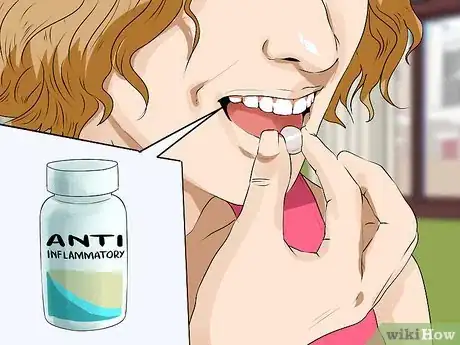

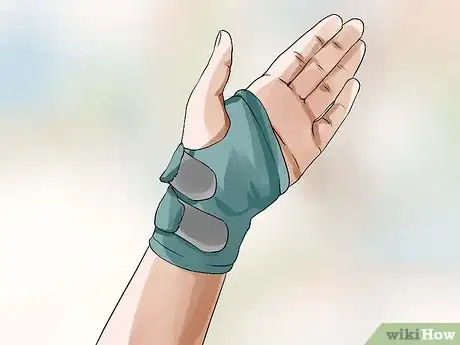
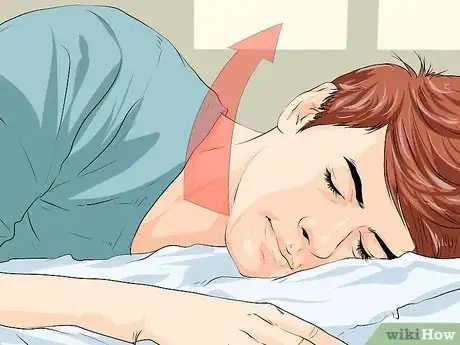
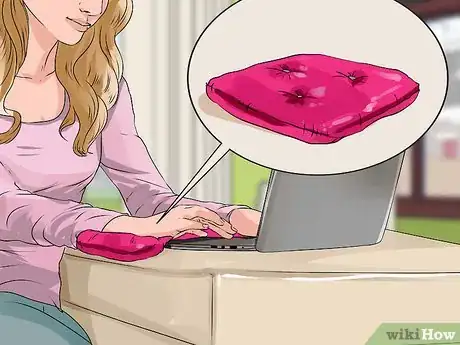


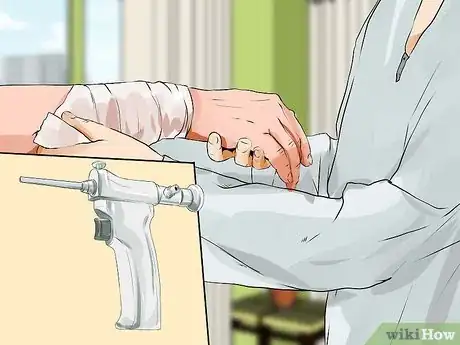
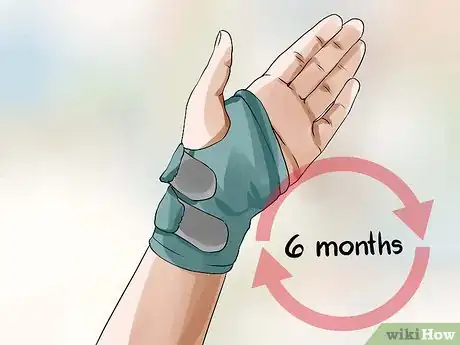
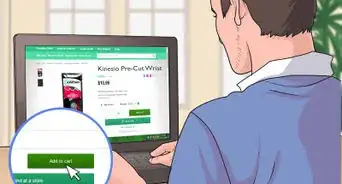





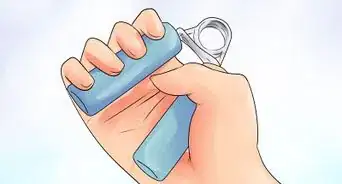


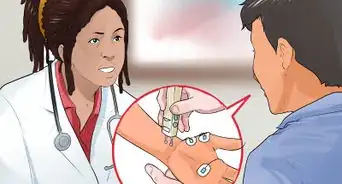












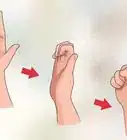





































Medical Disclaimer
The content of this article is not intended to be a substitute for professional medical advice, examination, diagnosis, or treatment. You should always contact your doctor or other qualified healthcare professional before starting, changing, or stopping any kind of health treatment.
Read More...